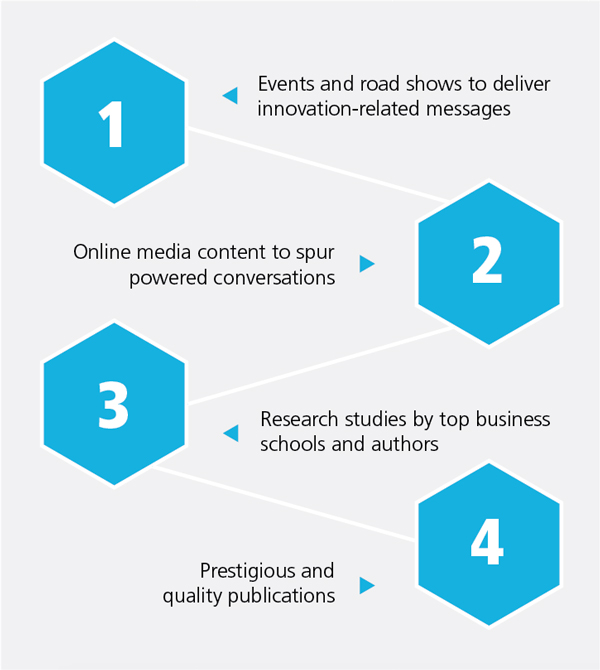By Alessandro Di Fiore, Elisa Farri and Andrea Segnalini
Developing innovation capabilities is no longer enough. For organisations, innovation marketing is the next frontier.
Appearances are important. Look at leadership. How a leader looks and behaves in front of followers is key to the successful practice of leadership. But, while we accept the importance of appearances in a range of business disciplines – marketing and communication for example – in some it is strangely under-valued.
Consider innovation. Companies invest in innovation to foster growth and competitiveness. This hopefully results in a higher Innovation Premium – the difference between the market cap and the NPV of cash flows. But, we were surprised when our research into the Innovation Premiums of major corporations found that they vary significantly among companies with the same financial fundamentals, even within the same industry.
We then examined what differentiated these companies. We found that where companies differ is primarily in their ability to explain to investors that they can sustain innovation. In innovation, reputation is crucial; being seen to be innovative is a vital differentiator. Seeing is believing.
Look at Salesforce.com, the San Francisco-based CRM company. According to the 2015 Forbes Most Innovative Companies ranking, Salesforce has a 78 percent Innovation Premium.1 This is almost double the industry average. Why? Salesforce not only has an innovation track record, but also a strong reputation as innovator. Marc Benioff, its CEO and founder, has successfully marketed the company’s innovativeness across different channels. It is an innovative organisation, but it also looks like one.
The reality is that innovation is a battle that has to be fought on two fronts. First, companies have to develop their innovation capabilities. Building long-lasting capabilities throughout the organisation lays the foundation for enduring innovation and growth. Today, most companies understand the importance of this first lever to sustain future performances. The real challenge here concerns execution.
The second front is the world of appearances. Compared to developing innovation capabilities, innovation marketing is neglected. But, our research suggests that it is vital. Investors need to be informed and convinced of a company’s ability to continue to innovate far into the future. This means being able to build a thought leadership profile on innovation, be known and perceived as an innovative company at the leading edge in the industry.
THE BARRIERS
Innovation capabilities and innovation marketing are both important. The second element is routinely overlooked.
There are three main barriers for this:
 • Obsession with confidentiality and privacy. Some companies, particularly those active in IP-sensitive industries, such as chemicals, are worried about breaches of confidentiality. Worry becomes paranoia and all the good things they are doing are automatically categorised as confidential, even when they are not sensitive. We have regularly met companies that have turned down the opportunity to be a case study for Harvard Business School or another leading business school. This is often self-defeating. The perceived risk of divulgating ‘confidential’ information to the external world hinders effective innovation marketing beyond the company.
• Obsession with confidentiality and privacy. Some companies, particularly those active in IP-sensitive industries, such as chemicals, are worried about breaches of confidentiality. Worry becomes paranoia and all the good things they are doing are automatically categorised as confidential, even when they are not sensitive. We have regularly met companies that have turned down the opportunity to be a case study for Harvard Business School or another leading business school. This is often self-defeating. The perceived risk of divulgating ‘confidential’ information to the external world hinders effective innovation marketing beyond the company.
• Reserved company culture. In some organisations, to broadly communicate what you have done and achieved, to ‘market’ them to raise your social visibility, is acceptable behaviour. In other companies the culture is the opposite. Having a low profile, speaking only through results, avoiding visibility are the norms. We found that having a reserved culture influences the style and intensity of a company’s communication with the outside world. Take the fast moving consumer goods industry. On one hand, there is P&G. Its culture can be described as ego-powered, self-centric, show you are the best. It has built a reputation and image on innovation through articles, books, case studies and research studies. It comes naturally to P&G to spend time, resources and effort to let the world know how great it is. On the other hand, Colgate-Palmolive has a reserved culture and it doesn’t come naturally for the company to invest time and resources to boost its innovation reputation beyond the standard corporate actions (annual reports, financial road shows, and so on).
• Lack of accountability. Often, there is no clear accountability for innovation marketing. The Chief Innovation Officer and the R&D VP are responsible for driving the company’s innovation funnel and priorities. Innovation marketing is not part of their individual goals and targets. The CFO and Investor Relationship Manager are focused on communicating to analysts on the company’s financial measures and how it is progressing on them. The External Communication Manager is usually focused on the old fashioned activities of press releases and sponsorships to raise a generic corporate image. In contrast, in our best practice cases, we found that the CEO was the driving force behind innovation marketing. Think of Marc Bienoff at Salesforce or AG Lafley at P&G in his first tenure. When the CEO is not driving innovation marketing, then the organisation is ill equipped to design and execute a proper innovation marketing plan.
Fig. 1 – Overview of the “Innovator’s Thought Leadership Framework”
THE INNOVATION MARKETING PLAN
While innovation marketing is often overlooked, as we have seen, there are exceptions, companies that match innovation capabilities with innovation marketing. Best practice companies use a number of levers, summarised in what we call the Innovator’s Thought Leadership Framework (see Figure 1 above), to raise their external innovation profile.
Intuit is a great example of a company that has increased and sustained its Innovation Premium by using most of the levers in the framework. Starting in the mid-2000s, Intuit has supported the diffusion of cutting-edge innovation methodologies – such as Customer-driven Innovation and Design for Delight – with the aim of strengthening innovation capabilities that create value for customers and the company. Moreover, Intuit has communicated the new capability-building programs through various channels:
• The company’s story was featured in prestigious books on management and innovation (The Innovator’s Method by N. Furr and J. Dyer; Inside Intuit by S. Taylor and K. Schroeder);
• Intuit has opened its doors to authoritative professors and researchers, who have published extensively on the company. For example, Harvard Business School has published more than 10 cases focusing on management practices and business challenges at Intuit;
• CEO Brad Smith and founder Scott Cook published Harvard Business Review articles and attended conferences, actively promoting Intuit as a leading innovator also in terms of management practices.
Not only did Intuit effectively communicate its ability to continue to innovate far into the future, but it also raised the company’s thought leadership and ‘coolness’ on innovation management practices to the eyes of the external world.
To create thought leadership, companies need to design a clear Innovation Marketing plan that states what the company should do. Content is the centerpiece. Companies should create content that is relevant and valuable and select the core messages to highlight their innovation capabilities in order to position the company as truly innovative.
Then, companies should identify the Collaborator they need to help build or amplify high-quality marketing messages covering their innovation profile. These collaborators may include expert journalists or authoritative professors who are interested in researching the company and publishing about it.
Finally, identifying the right communication Channels is crucial. Successful companies carefully screen the available channels, and identify priorities based on content and target audience. Clearly, online media is now a powerful communication channel. It enables companies to engage external people in online discussions about innovation-related topics. In addition, it prompts people to talk to each other about the company’s innovativeness. Traditional media should not be overlooked and be included in the Innovation Marketing plan. However, we believe that the use of traditional channels should be more selective. Prestigious management magazines, as well as academic journals, provide, for instance, the right communication link between the company, leading figures in innovation, authoritativeness and the targeted company’s innovation profile.
To organise the work plan around these three streams – Content, Collaborators, Channels – while keeping a constant eye on synergies and consistencies within the 3Cs will help companies to plan the right actions to raise their innovation profile.
CONCLUSION
Salesforce, Intuit and BASF have well understood that innovation marketing is the ticket to leverage the innovation capabilities and performances built inside, which leads to even higher Innovation Premiums.
Investors look for companies that are not only innovative, but spark meaningful change in the industry and its innovation practices through thought leadership. If you are doing it, then you should tell the world in a concerted and thought-through way. Shareholders value will benefit as well as your company’s reputation. Innovation marketing is the new frontier for innovation. Why wait?
About the Authors
 Alessandro Di Fiore (adifiore@ecsi-consulting.com) is the Founder and CEO of the European Centre for Strategic Innovation (ECSI)
Alessandro Di Fiore (adifiore@ecsi-consulting.com) is the Founder and CEO of the European Centre for Strategic Innovation (ECSI)
and ECSI Consulting (www.ecsi-consulting.com), London.

 Elisa Farri (left) is a Senior Consultant at ECSI Consulting, Milan. Andrea Segnalini (right) is a Consultant at ECSI Consulting, Milan.
Elisa Farri (left) is a Senior Consultant at ECSI Consulting, Milan. Andrea Segnalini (right) is a Consultant at ECSI Consulting, Milan.
Reference
1. http://www.forbes.com/innovative-companies/list/




































